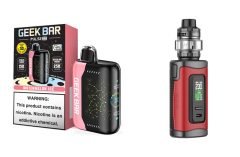Table of Contents [show]
Pleasure Vaping means finding better ways to increase flavor and vapor…safely
A Spinfuel Low Ohm High Wattage Primer
If you build your own coils, use mechanical mods are your primary device this article isn’t for you. Instead, this article addresses the massive move toward high wattage regulated devices and low ohm tanks and glassomizers among mainstream vapers.
In years past mainstream vapers were quite content with eGo or Spinner batteries and clearomizers with 2.4-ohm silica wicks. They used e liquid often made with a majority of Propylene Glycol (remember 80:20 blends?), and weren’t very concerned with making huge vapor “clouds”. That is changing.
A Mainstream Vaper is someone with a passive interest in vaping. They enjoy the hobby of vaping but have equal or greater interests in other aspects of life. A Mainstream Vaper is happy with their vape gear…until they’re not.
Mainstream vapers in 2015 are buying devices that output 30, 40, 50, 60, 80, 100, and even 150 watts and snatching up new tanks with coil heads with less than 1-ohms as they look for more vapor and more flavor than they ever did in the past. Most importantly, mainstream vapers are becoming Pleasure Vapers now, with no intention to quit vaping once they are sure that smoking cigarettes again is simply out of the realm of possibility.
Reader Trends
At Spinfuel eMagazine we know which of our reviews are popular and which ones are not so popular. We are communicating with mainstream vapers through email, Facebook, Google Plus, Twitter, as well as in comments, and talking with dozens and dozens of vapers at vape conventions and expos, and the indication on all fronts are that these same vapers that were once happy with their 650mAh batteries and inexpensive clearomizers are buying box mods and tanks in huge numbers. And although the cig-a-like market still attracts the majority of brand new vapers, they abandon those cig-a-likes faster than ever for a better vape experience.
The information below is directed at mainstream vapers that are still on the fence about high wattage/low ohm vaping, but have already moved beyond the cig-a-like…. Vapers that are currently vaping with variable voltage eGo/Spinner batteries and clearomizers with 2+ ohm coil heads.
Hopefully, this piece will help eliminate any fears or concerns about jumping off that fence and into the hottest trend in the short history of the electronic cigarette, higher wattage and lower ohms, and even temperature limiting vaping.
To Vape In 2015 And Beyond
Does the average Mainstream Vaper really need to understand ohms law, or various other electronic applications and theory in order to enjoy the art of vaping or to vape safely with higher wattage/ lowers ohm vape gear? No, not really, no more so than people that use computers need to know all about Moore’s Law. It can’t hurt to know more, but it’s not necessary to safely vape with high-powered regulated vaporizers and low ohm tanks. When Vapers begin to build their own coils for high end Rebuildables, and use mechanical mods that are not regulated it’s like vaping without a net, and then it’s time to learn about Ohm’s Law, and more, in order to make sure the risks are minimal.
Vaping with regulated devices have always been generally safe, and remains so despite the advent of higher wattage devices and lower ohms coils. The fact is that other than understanding some basic battery safety practices, Vapers need not worry about vape gear blowing up in their faces anymore. Though I do emphasize that the need to understand and practice battery safety is vital to minimizing that risk.
Coils And Coil Heads
Coils are thinly wrapped metal wire made of Kanthal, Nickel, or Titanium, and wrapped into a tight ‘coiled’ shapes and turn e liquid into vapor when enough energy is passed through it.
Coils are capable of heating up to different temperatures depending on several factors, including the gauge (thickness) of the wire, the actual metal used to make the coil, and even how the coils are wrapped. These factors determine the ‘resistance’ of the coils and that resistance is measured in ‘ohms’.
When energy, aka power, is sent from a vaporizer through the coil the amount of resistance will determine the temperature of the coil and its effectiveness to vaporize the e liquid when saturated in the wicking material threaded through the coil’s opening. It is that level of resistance, expressed as ‘standard resistance’, ‘low resistance’, and ‘high resistance’, that will determine the amount of power, aka energy, that will be needed to create an acceptable vape experience.
We could spend hours discussing the various resistance levels that a coil could have, but for our purposes today we will focus on ‘low resistance’ coils.
Measuring the amount of resistance running through the coil as power (watts) is applied to it is expressed in “ohms”.
Atomizer coils that possess Low Electrical Resistance can create more heat and warmer vapor when enough energy is sent through the coils. That energy, or power, is expressed in wattage. With the popularity of low resistance coils in modern vaping, we can honestly say that when it comes to resistance levels being used today, low resistance coils are the new ‘standard resistance’.
A New Standard Resistance
It is common in the vape community to refer to ohms resistances as ‘standard’, ‘low’, and ‘high’. A high resistance coil, as measured in ohms, is about 3.5-ohms. In today’s modern vape community, we seldom see anything like 3.5-ohms in use.
In 2015, the most common resistances (outside the subohm movement) in use are 1.5, 1.6, 1.8, and even 2.1 ohms. These ohms levels are now the new “Standard Resistance” simply because they are found in every type of clearomizer/glassomizer/tank made today.
Low Ohm Coils
Just as there is now a new ‘standard resistance’ there is a new ‘low resistance’ in 2015. Today, a low resistance coil is considered to be 1.2-ohms and lower. You might disagree based on what you prefer, but recent trends indicate that low resistance, or low ohm coils begin at the 1.2-ohm level and go lower from there.
1.2-ohm coils are quite popular among Mainstream Vapers as well as Advanced Vapers, and even lower ohm coils are gaining in popularity every day.
Sub-Ohm Coils
The hottest selling vape gear this year is higher wattage vaporizers and sub-ohm tanks. Most (but not all) sub-ohm tanks today ship with a 0.5-ohm coil installed into the tank, with a slightly higher-ohm coil in the box, usually 1.0-ohm, 1.2-ohm, or even 1.5-ohm with the new Kanger Subtank offerings. Several tanks include two 0.5-ohm, or lower, coils in the package.
The number of Vapers moving into sub-ohm territory accounts for a sizeable segment of the community now. In fact, chances are that if you are reading this the reason you’re here is your interest in sub-ohm vaping.
How Does Low Ohms Resistance Affect Vaping in General?
Ohms (coil resistance) contribute to four aspects of a satisfying vape. Throat Hit, which is becoming somewhat irrelevant in 2015, nicotine efficiency, flavor authenticity, and vapor production.
FACTOID: In 2013 a low ohm coil was between 1.5 – 1.8ohms; a standard ohm coil was generally between 2.4 – 2.8ohms; and high ohm is anything 3.0ohms or more.
This new desire for a better vape experience has Mainstream Vapers looking to lower and lower ohms resistance, with good reason, but high wattage/low ohm vaping is not all Sunshine and Lollipops, there are a few disadvantages as well. Here’s a very condensed list of the Pros and Cons.
Pros and Cons of Vaping in the Lower Ohms Territory
• Vapor is warmer, thicker, more aromatic
• Higher VG formula in e liquid adds even more vapor production
• Vaping satisfies with lower nicotine strengths
• Battery Life is shortened with lower ohms as well, because it takes more power to heat a low ohm coil
• E liquid is vaporized quickly, which means you’ll spend more money on e juice
Variable Wattage Regulated Vaporizers
Generally speaking, variable wattage regulated vaporizers began appearing in larger numbers in early 2014. Before that time variable voltage was all the rage. However, by the end of 2014 most new vaporizers were variable wattage devices, with a small number of variable voltage/variable wattage devices being released. In 2015 variable wattage devices out number any other type of vaporizer and easily exceed 30 watts, and in mid-2015 variable wattage devices were often 40 watts and above. Over the past few months Temperature Control devices, outside the Evolv DNA boards, began picking up the pace as well.
The vape gear you see being released by manufacturers today is mostly high wattage vaporizers and low ohm tanks and glassomizers. Just about everything we review these days is higher in wattage and lower in ohms than it was even just 12 months ago. Note* The eLeaf iStick 20w was reviewed by Spinfuel in August 2014, just a year ago. eLeaf just released their iStick 100w.
Mechanical Mod Death Knell?
Simply put, the mechanical mod is fast approaching its ‘end of life’ cycle. In its place are infinitely safer regulated vaporizers capable of producing high wattage, higher amperage devices capable of firing atomizers with coils in sub-ohm range down to 0.1-ohms, safely. Mech Mods are not completely dead, (our Skyladon review shows that) but the day is coming when they will be a rarity among Vapers, reserved for a small minority of purists. Even Vapers that vape using the ‘dripping’ technique are moving to regulated devices because they deliver all the power they need and do so safely, with minimal risk.
High VG E Liquid And Pleasure Vaping
I don’t want to spend a lot of time on e liquid in this piece but it is an important aspect of the successful move to high wattage/low ohm vaping. Simply put, with a high wattage vaporizer and a sub-ohm tank it is nearly impossible to vape e liquid that is PG rich with nicotine levels much above 12mg. For instance; many Vapers that used to vape 18mg nicotine formulas with standard resistance coils have moved down to 3mg or 6mg with high wattage/low ohm vape gear.
Higher wattage and lower ohm devices are very efficient at vaporizing e liquid as well as the nicotine in e liquid. Because the nicotine solution is vaporized more efficiently it takes less nicotine solution to maintain the same amount of nicotine in the bloodstream. While Spinfuel strongly believes that nicotine is no more harmful than caffeine, using less nicotine is good for everybody.
Because of the effectiveness of high wattage/low ohm vape gear most vapers would find high PG, high nicotine e liquid blends way too powerful to enjoy. In fact, over consumption of nicotine is probable in such a scenario.
PG, or Propylene Glycol, is known as the ‘flavor carrier’ in an eliquid recipe, as well as a major source for the throat hit effect, but it is also an irritant. Limiting the amount of propylene glycol decreases the irritant, while having little to no effect on the flavor output of a high VG blend.
Vegetable Glycerin, aka VG, is used for its ability to become a thick vapor when vaporized, and when vaporized in a higher wattage device with a low ohm coil the amount of vapor production goes through the roof. Vegetable Glycerin is much thicker than Propylene Glycol, and as such the higher the VG in an e liquid blend the thicker the e liquid will be. When thick VG e liquid is vaporized in a high wattage device with a low ohm coil the amount of e liquid consumed increases quite a bit. It is normal to double the amount of e liquid consumed in a day when switching from an 80:20 PG/VG to a 30:70 PG/VG blend.
Temperature Control
The temperature control feature in modern vaporizers only work with Nickel (Ni200) or Titanium (Ti) wires currently. However, shortly after we publish this piece two companies will introduce temperature control technologies in their devices that will work with Kanthal wire.
The most recent trend in vaping this year, especially with Pleasure Vapers is temperature control vaporizers. We’ve seen a sizable increase in temperature-controlled devices in the last few months alone. The Evolv DNA40, and soon the Evolv DNA200, as well as the YiHi SX350J chips are in big demand now, and so are other temperature control ‘platforms’ by manufacturers such as Joyetech, Innokin, eLeaf, and Sigelei. Their versions of temperature control, or temperature-limiting technology is just as effective as Evolv and YiHi platforms.
Temperature control, also referred to as ‘temperature limiting’ allows the Vaper to set the temperature to which the coils allowed to reach before shutting down the power to the point that limits the heat the coils can reach. This type of control prevents lower ohm coils made with Nickel or Titanium (currently) from reaching the desired temperature when there isn’t enough e liquid saturating the cotton wicking threaded through the coils, thereby preventing dry burns.
A dry hit/dry burn is a horrible experience to endure. Without this temperature limiting tech the vaporizer does not reduce the power going to the coils and it can send a massive amount of raw heat directly to the back of the Vaper’s throat. The only issue preventing a total migration to temperature control vaporizers is the need to use Nickel (or Titanium with Joyetech) coils. Not all tank manufacturers offer prebuilt Nickel (or Ti) coil heads so Vapers must purchase specific tanks as well as the optional Ni200 or Ti coil heads. Once this technology works with standard Kanthal wire we believe the adoption of Temp Control devices will skyrocket.
Trending Now…
The trend is obvious, and we see no signs of a slowdown. Manufacturers are upping the wattage in everything they make, tank manufacturers are producing lower ohm coil heads for their new tanks, and well established e liquid brands are introducing High VG versions of their best selling flavors and will eventually offer all their eliquid blends in High VG. Within a year the 80:20 or 70:30 PG/VG e liquids may disappear altogether.
Conclusion
The numbers of Pleasure Vapers are increasing as more and more people leave tobacco behind and continue to stay with vaping long after they need to. Because there is no inherent danger with vaping, ex-smokers see no reason to stop vaping, certainly not for ‘health’ reasons anyway. We vape now because we find pleasure in it. Using modern vape gear we are finding even more pleasurable ways to vape. Thick clouds of vapor, intense and authentic flavors, and less nicotine… isn’t this what we’ve all been waiting for?
Tom McBride, Jason Little, and John Manzione




